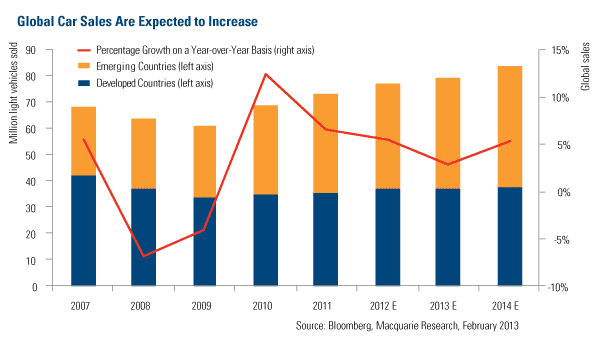Energy and Natural Resources Market Radar (February 24, 2013)

Strengths
- U.S. existing home sales increased 0.4 percent month-over-month to 4.92 million units at an annualized rate in January, and the number of unsold properties declined to the lowest level since 1999. For comparison, total sales last year were 4.66 million units, the highest number since 2007. According to Macquarie, this data suggests the U.S. housing market recovery continues to progress, and further positives can be drawn from the fact that distressed sales continued to decline as a proportion of existing home sales, accounting for 23 percent of the total last month, compared with 35 percent in January 2011.
- World industrial production, a key determinant of metals demand, rose a seasonally adjusted 0.6 percent month-over-month in December 2012, according to research group CPB. On a year-over-year basis output was 2.8 percent higher, a relatively modest increase, with production in the advanced economies down 0.8 percent year-over-year and in emerging economies up 5.9 percent year-over-year. The data underlines the contrasting fortunes in industrial production seen in the last decade, with output in the advanced economies in 2012 as a whole just 1 percent higher than it was in 2000; over the same period it has risen by 141 percent in the emerging economies.
Weaknesses
- Oil prices fell this week as the NYMEX crude oil contract settled at $92.84 on Thursday, the lowest settlement this year on continued weakness following the Department of Energy weekly supply report showing that crude inventory climbed to the highest level since July. Selling pressure also weighed on crude as indications that Saudi Arabia would raise production in the second quarter after making sizable cuts to supply since late last year.
- Commodities endured a broad-based sell-off this week as the U.S. Dollar strengthened after the Federal Open Market Committee minutes revealed concerns about costs and risks of further asset purchasing plans. Tighter policy aimed at property speculation in China and liquidity withdraw by the People’s Bank of China (PBOC) also exacerbated market fears. Most industrial metals have given up their gains year to date and moved into negative-return territory.
Opportunities
- China has a “structural shortage” in its grain supply because demand continues to rise, Minister of Agriculture Han Changfu said in a statement posted on the central government website. For the second year, China has been a net importer of rice, wheat and corn, Han said. China faces a “very difficult task” balancing its grain demand and supply, according to the statement, which summarized the minister’s speech at a February 17 national conference on this year’s planting.
- Japanese Prime Minister Shinzo Abe will ask President Barack Obama to allow shale gas exports as the world’s third-largest economy grapples with soaring energy costs after 2011’s nuclear disaster closed reactors. The request will be made at a meeting Saturday between Abe and Obama in Washington, said three Japanese officials, who declined to be identified because the information isn’t public. The bill for importing liquefied natural gas (LNG), combined with a weaker yen, prompted Japan to post a record trade deficit in January of 1.63 trillion yen ($17.4 billion), the Finance Ministry said yesterday. The switch from nuclear to gas-fired generation after the accident at Fukushima forced Japan to increase LNG imports 11 percent last year. Abe wants Obama to share the benefit of surging output from shale fields, which has depressed the cost of U.S. gas to about 20 percent of Asian prices, by approving export terminals. Some U.S. politicians oppose shipments overseas because the lower energy costs are making manufacturers more competitive, helping to create factory jobs.
Threats
- Grain prices will fall "significantly" in 2013 due to strong corn and soybean production in 2013, U.S. Department of Agriculture’s chief economist predicted this week at the agency’s annual Agricultural Outlook Conference in Arlington, Virginia. Joe Glauber predicted that corn prices will average $4.80 a bushel in 2013-2014, down 33 percent from the marketing year before. Soybean prices, he estimated, would fall 27 percent to $10.50 per bushel. A return to normal weather conditions, he predicted, will result in higher production that will depress prices.
- Bloomberg news reported that a tax break used by oil and gas pipeline companies such as Kinder Morgan Energy Partners LP will cost the U.S. government $7 billion through 2016, about four times more than previously estimated, Congress’s tax scorekeepers said this month. The nonpartisan Joint Committee on Taxation quadrupled its cost estimate for exempting the fast-growing “master limited partnerships” from corporate income tax in the year ended in September to $1.2 billion from $300 million. The annual cost will rise to $1.6 billion by fiscal 2016, the committee said. The revision reflects the growth of tax-free publicly traded partnerships. They have taken over the U.S. pipeline business and are expanding into the rest of the oil and gas industry, partly by gobbling up dozens of tax-paying companies. With President Obama and congressional Republicans calling for a tax overhaul, the higher cost estimate may make it harder for industry to protect the MLP subsidy, said John Buckley, a tax professor at Georgetown University Law Center.











